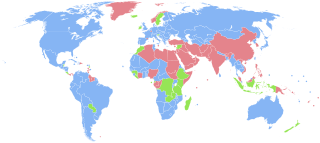
Back लिंगानुपात के आधार पर भारत के राज्यों की सूची Hindi భారత రాష్ట్రాల లింగ నిష్పత్తి Tegulu بھارتی ریاستوں اور علاقہ جات کی فہرست بلحاظ جنسی تناسب Urdu

Countries with more females than males Countries with more males than females Countries with very similar proportions of males and females (to 3 significant figures, i.e., 1.00 males to 1.00 females) No data |
Graphs are unavailable due to technical issues. There is more info on Phabricator and on MediaWiki.org. |
Sex ratio is used to describe the ratio of females to males in a population. In India, the sex ratio has been estimated via a number of methods and data sets including the decennial censuses, the National Family Health Surveys (NFHS), the Civil Registration System, the Sample Registration System and the Health Management Information System.[5] In 2014, the ratio of female births per 1000 male births varied from 887 to 918 using these estimates.[6] According to the NFHS-4 (2015–16) sex ratio of the total population (females per 1,000 males) was 991 (with an urban ratio of 956 and a rural ratio of 1,009).[4]
In 2011–2013, it was revealed through a population census with the Sample Registration System (SRS) that the sex ratio of India was 909 females per 1000 of males.[7] It has skewed downwards from then, recording 900 females in 2013–2015 and 896 in 2015–17 per 1000 of males.[7][8] Furthermore, that survey conducted with the SRS also showed Chhattisgarh as the highest sex ratio at 961, while Haryana was recorded the lowest at 831.[8]
The male-skew in India's sex ratio has increased since the early 20th century. In 1901 there were 3.2 million fewer women than men in India, but by the 2001 Census the disparity had increased by more than a factor of 10, to 35 million.[9] This increase has been variously attributed to female infanticide, selective abortions (aided by increasing access to prenatal sex discernment procedures), and female child neglect.[9] It has been suggested that the motivation for this selection against female children is due to the lower status and perceived usefulness of women in India's patriarchal society.
- ^ Data from the CIA World Factbook [1] Archived 12 August 2008 at the Wayback Machine. Map compiled in 2021, data from 2020.
- ^ "5: Gender Composition of the Population" (PDF), Provisional Population Totals – India, pp. 78–96
- ^ "1: Population" (PDF), Women and Men in India. Population related statistics., Ministry of Statistics and Programme Implementation
- ^ a b "National Family Health Survey (NFHS-4): India Fact Sheet" (PDF). rchiips.org. Ministry of Health and Family Welfare, Government of India. International Institute for Population Sciences, Mumbai. 2015–2016. Retrieved 10 September 2021.
{{cite web}}: CS1 maint: others (link) - ^ UNPFA, Sex Ratio at Birth in India (2020), 3.
- ^ UNPFA, Sex Ratio at Birth in India (2020), 5.
- ^ a b "Sex Ratio at Birth – India & Larger States". NITI Aayog. Archived from the original on 12 August 2021. Retrieved 8 September 2021.
- ^ a b Tripathi, Rahul (15 July 2019). "Survey shows sex ratio falling further to 896 in 3 years to 2017". The Economic Times. Retrieved 8 September 2021.
- ^ a b Bakshi, Roopa. "Declining sex-ratios – a matter of concern". UNICEF. Archived from the original on 14 September 2019. Retrieved 30 July 2018.